Phone: +27-(0)21-808-5840
Fax: +27-(0)21-808-5863
Email: dub@sun.ac.za
Educational Background
B Sc Agric (Biochemistry, Genetics, Animal Physiology) University of Stellenbosch
B Sc Agric Hons (Biochemistry) University of Stellenbosch
M Sc Agric (Biochemistry) University of Stellenbosch
Ph D Agric (Biochemistry)University ofStellenbosch
Research techniques and fields
Immunoassays, Immunology, Nucleic acid-based detection technologies (PCR, RT-PCR, qPCR , microsatellites), Molecular Systematics, Next Generation Sequencing, Genomics
Commercial applications of my research
- An ELISA kit for the detection of Ralstonia solanacearum in potato tubers. This has been used by the Potato Certification Services in South Africa for certification of disease free seed potatoes since 1995 (for more information, see below).
- Custom antibody production in rabbits against protein antigens using acid-treated, naked bacteria (Bellstedt et al., (1987) J. Imm. Methods 98, 249-255.). This method works successfully to raise antibodies against isolated or recombinant proteins and is offered as a service to researchers in South Africa and elsewhere.
Current Research
1. Investigations into the evolution of viruses and bacterial pathogens of potatoes and fruit trees and their detection.
2. Plant molecular systematic and evolutionary studies of plant groups that occur in southern Africa focusing on the Cape Floral Region.
3. The development of DNA vaccines against ostrich mycoplasmas.
4. Fish Phylogenetics.
Description of Research
Investigations into the evolution of viruses and bacterial pathogens that infect potatoes and fruit trees and their detection
In these
projects, immunoassay and PCR-based techniques are used for the
detection of viral and bacterial pathogens, gene sequencing and
molecular systematic approaches are used to understand the nature of the
evolution of viruses and bacteria infecting potatoes and fruit trees in
South Africa. Research conducted for Potatoes SA on Potato Virus Y (PVY) has shown that the PVYO and PVYN occur in South Africa, but have largely been replaced by the recombinant PVYNWilga and PVYNTN strains
as well as other recombinant strains which have also been detected in
other areas of the world (4). We have developed a novel approach to the
phylogenetic analysis of PVY whole genome sequences to accommodate for
the recombination which occurs frequently between the different strains
of virus (4). Our team is part of the international PVY Wide Organization (http://www.inra.fr/pvy_organization_eng).
Realtime RTPCR tests were developed for the detection of PVY and Potato
Leafroll Virus (PLRV) and these are now applied in research and for
confirmatory testing in the industry. We are currently conducting trials
to assess the resistance against PVYNTN strains
of the main potato cultivars planted in South Africa with the objective
of drawing up a resistance index for local farmers. A
survey to establish the occurrence of Potato Virus X, Potato Virus M,
Potato Virus A and Potato Virus S in South African potato stocks
revealed that only isolated occurrences of Potato Virus A were found (M
Sc, Mr Wiets Roos). | 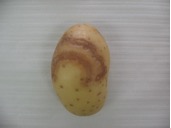 |
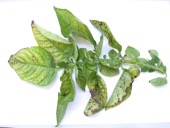 |
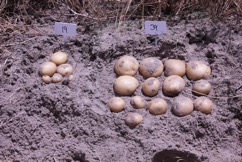
Two studies (M Sc theses, Mrs Sophie Malan and Miss M C Gagiano) on assessments of the occurrence of the fruit tree viruses, Apple Chlorotic Leaf Spot Virus, Apple Mosaic Virus, Apple Stem Grooving Virus, and Apple Stem Pitting Virus by RTPCR and strain identification by coat protein sequencing have revealed that a number of isolates of each these viruses occur in South African pome and stone fruit. RTPCR was found to be more sensitive for their detection than ELISA. As a result, RTPCR testing will be implemented as an additional detection method in the certification scheme for fruit trees in South Africa (http://www.saplant.co.za/).
In 1989, I developed an ELISA for the detection of bacterial wilt in potatoes caused by Ralstonia solanacearum which was posing a severe threat to the SA potato industry. This ELISA is still used routinely as part of the certification system of the South African Potato Industry (Potatoes SA) and has brought the disease under control in this country (1). We also confirm Ralstonia solanacearum infections and identify other bacterial infections by 16S rRNA sequencing.
Collaborators
Dr Emmanuel Jacquot, INRA-CIRAD-Supagro, UMR385 BGPI (Biology and Genetic of Plant-Pathogen Interactions), Montpellier, France. Dr Christophe Lacomme, Science and Advice for Scottish Agriculture (SASA), Edinburgh, UK.
Current student (2015)
PhD: Mr Wiets Roos entitled: "Genomic and pathogenicity assessments of South African isolates of Potato Leaf Roll Virus".
Past students (theses are available on the SU website)
Mr Mark Matzopoulos (MSc, graduated March 2006); Ms Adri Rothman (MSc, graduated March 2007); Dr J. Chris Visser (MSc, graduated March 2008); Dr J. Chris Visser (PhD, graduated March 2012); Mr Wiets Roos (MSc, graduated March 2013); Mrs Sophie Malan (MSc, Plant Pathology, graduated December 2014); Ms Emcee Gagiano (MSc, Plant Pathology, graduated March 2015).
Publications
- Bellstedt, D.U. Enzyme-linked immunosorbent assay detection of Ralstonia solanacearum in potatoes: the South African experience. (2009) In Methods in Molecular Biology, Volume 508: Plant pathology: techniques and protocols, pp. 51-62, The Humana Press, New Jersey, USA.
- Visser, J. C. and D. U. Bellstedt (2009) An assessment of molecular variability and recombination patterns in South African strains of Potato virus Y. Archives of Virology 154, 1891-1900.
- Cuevas J. M. , A. Delaunay, J. C. Visser, D. U. Bellstedt, E. Jacquot, S. Elena. (2012) Phylogeography and Molecular Evolution of Potato virus Y. PLoS ONE 7(5):e37853. doi:10.1371/journal.pone.0037853.
- Visser, J. C., D.U. Bellstedt and M.D. Pirie (2012) The recent recombinant evolution of a major crop pathogen, Potato virus Y. PloS One 7(11) e50631.
Plant molecular systematics, biogeography and bioinformatics
In collaboration with a number of local and international botanists, we have researched phylogenetic relationships in the genera Disa (and close relatives), Erica, Oxalis, Streptocarpus (see also contributions to the Gesneriad Reference Web: http://www.gesneriads.ca/), Ursinia and Zygophyllum. This research contributes crucially to biodiversity assessments in South Africa and has lead to the description of a number of new species. Key objectives of this research are not only to establish the phylogenetic relationships of the taxa in their relevant groups, but also to use the phylogenies in studies on their biogeography (Disa, Zygophyllum, Erica), the evolution of C4 photosynthesis (Zygophyllum), and floral morphology (Streptocarpus, Erica). The techniques applied in this research are DNA isolation, PCR amplication of specific gene regions (also directly from plant material, see 10) followed by cycle sequencing. Recently, Ion Torrent sequencing has been used to sequence whole chloroplast genomes for phylogenetic inference in the subfamily Zygophylloideae (M Sc, P D W van der Merwe). Bioinformatics, phylogenetic analysis and optimization methods are used to analyse the generated data. A major thrust of our current research is aimed at establishing the phylogenetic relationships of the genus Erica, which is the most species rich genus (~650 species) in the Cape Floral Region. A phylogeny based on a large number of marker genes is in an advanced state of completion. Illumina NGS has been employed to sequence the genome of Erica plukenetii and this genome will be used to investigate the role of genes encoding for enzymes that synthesize red flower colour and flower morphology using bioinformatics tools. Since 2003, the critically endangered orchid, Disa barbata, has been monitored and propagated by tissue culture (by Cape Institute of Micropropagation). The first plants were re-introduced into nature in the Kenilworth Race Course area during 2007. Collaborators
Dr Benny Bytebier, University of Kwa-Zulu Natal, South Africa, collaboration on orchids.
Dr Gudrun Kadereit, University of Mainz, Germany, collaboration on Zygophyllum and other families that possess C4 photosynthetic mechanisms.
Prof H Peter Linder, Institute of Systematic Botany, University of Zurich, Switzerland, collaboration on orchids.
Dr Michael Moeller, Royal Botanic Gardens Edinburgh, UK, collaboration on Streptocarpus.
Dr Michael D Pirie, University of Mainz, Germany and University of Stellenbosch, SA, collaboration on Erica. |  |
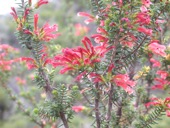 |
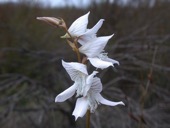 |
Current students (2015)
Ph D: Mr Nicolas le Maitre, Mr Pieter de Wet van der Merwe.
Past students
Dr Benny Bytebier (Ph D, graduated March 2007); Nonkululeko Swelankomo (MSc, graduated March 2008); Dr Margaret J de Villiers (PhD, graduated December 2008); Kenneth Oberlander (PhD, graduated March 2009); Dr Michael D Pirie (post-doctoral fellow, 2008-2013); Dr Margaret J de Villiers (PhD, post-doctoral fellow, 2009-2013); Mr Pieter de Wet van der Merwe (MSc, graduated March 2015).
Publications since 2007
- Galley, C., Bytebier, B., D. U. Bellstedt and H. P. Linder (2007) The Cape component in the afrotemperate flora: from Cape to Cairo? Proceedings of the Royal Society B: Biological Sciences 274, 535-543.
- Bytebier, B., D. U. Bellstedt and H. P. Linder (2007) A molecular phylogeny for the large African orchid genus Disa. Molecular Phylogenetics and Evolution 43, 75-90.
- Hughes, M., M. Möller, T.J. Edwards, D.U. Bellstedt and M. de Villiers (2007) The impact of pollination syndrome and habitat on gene flow – a comparative study of two Streptocarpus species. American Journal of Botany 94, 1688 - 1695.
- Bytebier B.L.G., T. Van der Niet, D.U. Bellstedt and H.P. Linder (2008) The phylogenetic position of the enigmatic orchid genus Pachites Lindl. South African Journal of Botany, 74, 306–312.
- Bellstedt, D. U., L. van Zyl, E.M. Marais, B. L. G. Bytebier, C. A. de Villiers, A. M. Makwarela and L.L. Dreyer (2008) Phylogenetic relationships, character evolution and biogeography of southern African members of genus Zygophyllum (Zygophyllaceae) based on three plastid regions. Molecular Phylogenetics and Evolution 47, 932-949.
- Bytebier B. L. G., D. U. Bellstedt and H. P. Linder (2008) A new phylogeny-based sectional classification for the large African orchid genus Disa. Taxon 57, 1233-1251.
- Edwards, T. J., M. Hughes, M. Möller and D. U. Bellstedt (2008) New Streptocarpus species (Gesneriaceae) from South Africa. Botanical Journal of the Linnean Society 158, 743-748.
- Verboom, G. A., J. K. Archibald, F. T. Bakker, D. U. Bellstedt, F. Conrad, L. L. Dreyer, F. Forest, C. Galley, P. Goldblatt, J. F. Henning, K. Mummenhoff, H. P. Linder, A. M. Muasya, K. C. Oberlander, V. Savolainen, D. A. Snijman, T. van der Niet, T. L. Nowell (2009) Origin and diversification of the Greater Cape flora: ancient species repository, hot-bed of recent radiation, or both? Molecular Phylogenetics and Evolution, 51, 44-53.
- Oberlander, K. C., E. Emshwiller, D. U. Bellstedt and L. L. Dreyer (2009) A model of bulb evolution in the eudicot genus Oxalis (Oxalidaceae). Molecular Phylogenetics and Evolution, 51, 54-63.
- Bellstedt, D. U., M. D. Pirie, J. C. Visser, M. J. de Villiers and B. Gehrke (2010) A rapid and inexpensive method for the direct PCR amplification of DNA from plants. American Journal of Botany 97, e65-e68.
- Bytebier, B., A. Antonelli, D. U. Bellstedt and H. P. Linder (2011) Estimating the age of fire in the Cape flora of South Africa from an orchid phylogeny. Proceedings of the Royal Society B: Biological Sciences 278, 188-195.
- Warren, B. H., F. T. Bakker, D. U. Bellstedt, B. Bytebier, R. Claßen-Bockhoff, L. L. Dreyer, D. Edwards, F. Forest, C. Galley, C. R. Hardy, H. P. Linder, A. M. Muasya, K. Mummenhoff, K. C. Oberlander, M. Quint, J. E. Richardson, V. Savolainen, B. D. Schrire, T. van der Niet, G. A. Verboom, C. Yesson & J. A. Hawkins (2011) Consistent phenological shifts in the making of a biodiversity hotspot: the Cape flora. BMC Evolutionary Biology 2011, 11:39.
- Davies, T. Jonathan, G. F. Smith, D. U. Bellstedt, J. S. Boatwright, B. Bytebier, R.M. Cowling, F. Forest, J. Luke, A. Harmon, M. Muasya, B. Schrire, Y. Steenkamp, M. van der Bank, V. Savolainen (2011) Extinction Risk and Diversification Are Linked in a Plant Biodiversity Hotspot. PloS Biology 9, Issue 5, e1000620.
- Pirie, Michael D., E. G. H. Oliver and Dirk U. Bellstedt (2011) A densely sampled ITS phylogeny of the Cape flagship genus Erica L. reveals numerous shifts in floral macro-morphology. Molecular Phylogenetics and Evolution 61, 593-601.
- Oberlander, K. C., L. L. Dreyer and D. U. Bellstedt (2011) Molecular phylogenetics and origins of southern African Oxalis. Taxon 60, 1667- 1677.
- Thompson G.D., D.U. Bellstedt, M. Byrne, M.A. Millar, D.M. Richardson, J.R.U. Wilson and J.J. le Roux (2012) Cultivation shapes genetic novelty in a globally important invader. Molecular Ecology 21, 3187–3199.
- De Villiers, M.J., M.D. Pirie, M. Hughes, M. Möller, T.J. Edwards, and D.U. Bellstedt (2013) An approach to identify putative hybrids in the 'coalescent stochasticity zone', as exemplified in the African plant genus Streptocarpus (Gesneriaceae). New Phytologist 198, 284-300.
- Thompson, G.D., D.U. Bellstedt, D.M. Richardson, J.R.U. Wilson and J.J. Le Roux (2015) A tree well-travelled: Global phylogeography of the invasive Acacia saligna. Journal of Biogeography 42, 305-314.
DNA vaccine development against ostrich mycoplasmas
See Botes Group.
Fish Phylogenetics
Due to my expertise in genomics and phylogenetic analysis, as well as a considerable knowledge of tropical fishes, I have been approached to become a collaborator in a Geoecodynamics project. Geoecodynamics is a cross-disciplinary field in which fish phylogenomic data are used to reconstruct the landscape evolution of a specific area developed by Dr Fenton P D Cotterill (see https://sites.google.com/site/fpdcotterill/research/landscape-evolution-and-african-geology). Due to my knowledge of the one group of fishes that are to be analysed, i.e. Nothobranchius, Dr Cotterill and I have embarked on a phylogenetic project on the genus focussing on the areas of Zambia, Botswana and the Congo. This project is in an advanced state and the results of this study are almost complete for publication.
Collaborators
Dr F P D Cotterill, Department of Botany and Zoology, University of Stellenbosch
Prof Brian Watters, professor emeritus, Department of Geology, University of Saskatchawan, Canada
Mr Béla Nagy, Fontainebleau, France.
The second project currently in progress in my laboratory is on the South American fish genus Pterophyllum. Three species are currently recognized in this species, but the vast area inhabited by these species, species distribution overlaps, and re-establishment of a direct riverine link between the Rio Orinoco and the Rio Negro (as part of the Amazon drainage), the so-called Rio Casiquiare or Casiquiare Canal, have resulted in intermediate forms which require DNA sequence analysis to unravel their evolutionary histories. In order to conduct this study, samples have been supplied by collaborators in Europe and the USA, who in turn have obtained these samples from collaborators in Venezuela and Colombia.
Collaborators
Dr Ulrich Schliewen, The Bavarian State Collection of Zoology, Department of Ichthyology, Munich, Germany
Mr Edgar Ruiz, Salt Lake City, USA.
Current students
Ms Chanelle Anderson, M Sc on the molecular systematics of Pterophyllum.

